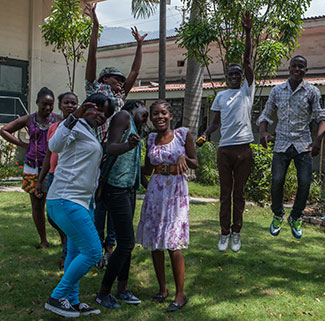Fogarty's adolescent research key to future good health
March / April 2018 | Volume 17, Number 2

Photo courtesy of GHESKIO
Adolescents are often overlooked by health researchers but
have unique health issues that require study.
By Karin Zeitvogel
The world is sitting on a global health time bomb as the largest adolescent population in history - 1.8 billion youth - transitions into adulthood. HIV deaths among adolescents are rising, even as they decline for other age groups. AIDS-related illnesses claim more adolescent lives than any other cause except road accidents, according to UNAIDS. Adolescence is a time of risk-taking, when many social behaviors related to health - things like smoking, drinking, sexual behaviors and delinquency - are established.
"It's a time of a whole set of serious social transformations which are important for adolescents but really have major importance down the road," said adolescent health specialist and long-time National Institute of Child Health and Human Development (NICHD) grantee, Dr. John Santelli of Columbia University. "Adolescents don't die from tobacco use but if you wait 20-30 years, you'll see the serious health consequences of teen smoking. And then, of course, in most of the world, adolescents rapidly become the parents of tomorrow. So their health, their well-being predicts the health of their children."
And yet, until recently, the health needs of adolescents have been largely overlooked by the research community. "Adolescents are perceived by many researchers and policymakers to be a healthy lot, with few pressing needs," said Fogarty grantee, Dr. Monika Arora, director of the health promotion division at the Public Health Foundation of India - the country with the largest number of adolescents in the world. "But adolescent mortality has fallen at a slower rate than it has in children aged 0 to 9 years old, and the adolescent age group is the only one in which AIDS-related deaths are not decreasing."
Adolescent research has lagged behind other age groups, in part because the factors that influence youth health - the conditions in which a person is born, grows, lives, works and ages - fall outside the health system. Called the social determinants of health, these include how long youth stay in school, how a country regulates tobacco and alcohol, child marriage, the poverty rate, and so on. Behaviors adopted during this time of life can impact youth in the short term, when they're older, and influence the quality of life and health of the next generation.
Every year, more than 18 million girls, some younger than 15, give birth in developing regions, according to the WHO. Complications during pregnancy and childbirth are the leading cause of death for 15- to 19-year-old females globally and giving birth during adolescence has a negative impact on the future well-being of both mothers and infants.
Fogarty has long supported research into multiple aspects of youth health, from tobacco use to teen pregnancy and how it affects women's health later in life, to HIV testing and care. Many Fogarty-funded projects take a multisectoral, life-course approach to adolescent health, looking not just at the clinical aspects of teen health but also seeking to address the social determinants that impact health from the time a child is in the womb through adolescence and into adulthood.
More Information
- Related publications:
-
Our future: a Lancet commission on adolescent health and wellbeing
The Lancet, May 11, 2016 -
Global burden of diseases, injuries, and risk factors for young people's health during 1990–2013: a systematic analysis for the Global Burden of Disease Study 2013
The Lancet, June 11–17, 2016 -
Adolescence and the social determinants of health
The Lancet, April 28–May 4, 2012 -
Living and dying to be counted: What we know about the epidemiology of the global adolescent HIV epidemic
Journal of the International AIDS Society, May 2017 -
Fact sheet: Adolescent pregnancy
World Health Organization (WHO), updated January 2018 -
The age of adolescence
The Lancet Child and Adolescent Health, March 2018
- Resources related to the article
Teen pregnancy can impact health for a lifetime:
- Resources related to the article
Healthy habits in teens help reduce noncommunicable disease burden:
- Resources related to the article
Fogarty supports research to fight HIV/AIDS in teens:
- Haiti:
- Belize:
- Tanzania:
- Uganda:
- About the
Rakai Adolescent Project (RAP), supported by the
National Institute of Child Health and Human Development (NICHD)
- Related publications:
-
Rising School Enrollment and Declining HIV and Pregnancy Risk Among Adolescents in Rakai District, Uganda, 1994-2013
Global Social Welfare: Research, Policy & Practice, June 2015 -
Prevalence of Sexual Experience and Initiation of Sexual Intercourse among Adolescents, Rakai District, Uganda, 1994–2011
Journal of Adolescent Health, November 2015 -
Trends in HIV acquisition, risk factors and prevention policies among youth in Uganda, 1999–2011
AIDS, January 14, 2015 -
Importance of Relationship Context in HIV Transmission: Results From a Qualitative Case-Control Study in Rakai, Uganda
American Journal of Public Health, March 12, 2014 -
Behavioral, Biological, and Demographic Risk and Protective Factors for New HIV Infections among Youth, Rakai, Uganda
Journal of Acquired Immune Deficiency Syndromes, July 1, 2013
- Nigeria:
To view Adobe PDF files,
download current, free accessible plug-ins from Adobe's website.